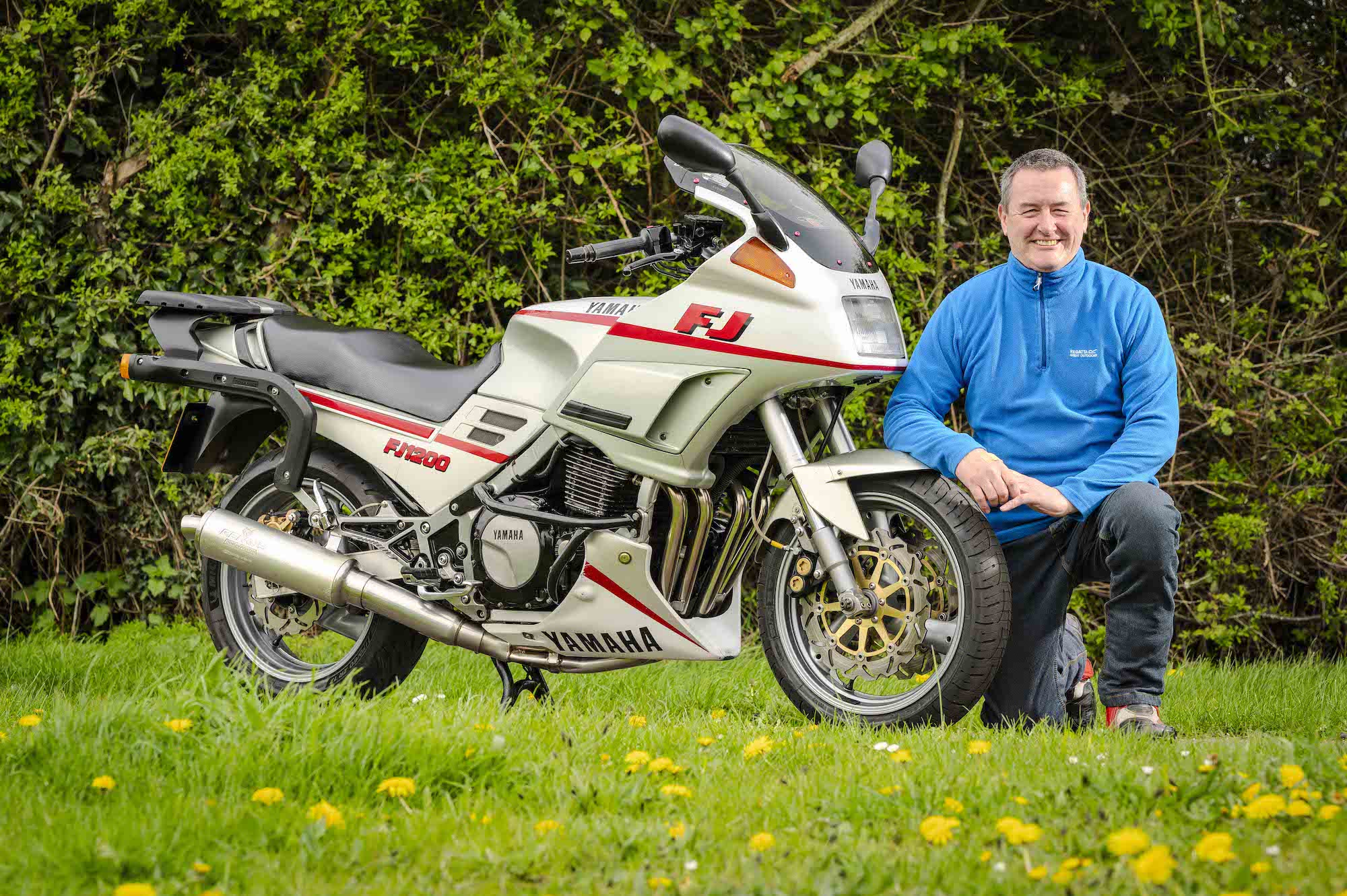Like many bike-obsessed teenagers growing up in the ‘70s, Martin James had a poster on his wall of Kenny Roberts, knee down, racing the iconic yellow and black Yamaha.
“I was Yamaha through and through,” says Martin, who graduated from an RD125 and an RD200 to his dream bike at the age of 19 – a brand new RD400, yellow and black, of course.
He remembers paying £815 for the bike from Giffs Motorcycles of Wealdstone.
“It was a very old fashioned little shop,” he says, “and I had a friend who worked there. I walked in one day and said I wanted an RD400, which they had to order in specially.
“They used to come two to a crate, so they ordered a pair. I had mine, and the other one was in their window for about six months.”
He fitted slightly lower handlebars and painted the wheels gold but, after 18 months, upgraded to an early Yamaha XS750, a more pillion-friendly bike for a passenger, his then girlfriend, and now wife, Lorraine.
Yamaha nostalgia
Over the next decade and a half, various bikes came and went before Martin, now 66, started hankering after another RD400, a decision born of nostalgia and a bad experience with a Norton Commando.
“I’d always fancied a big British bike,” he says, at his home near Rugby. “But apart from the fact it was unbelievably slow, it was restored by a marque specialist and it was the first in my journey of understanding that you never buy a bike someone else has restored.
“The final straw was down at the Waterman pub at Hatton (near Warwick), which used to have huge bike nights.
“One summer evening I went down there with Lorraine on the back, and we came to leave and it wouldn’t start. I kicked it and kicked it, and by now, as you can imagine, a crowd was gathering and could sense blood.
“Finally, with one last lunge, I got it going and spluttered off up the hill. When I got home, I realised that the choke cable had broken and, as a result, the choke was stuck on, and there’s me trying to start it on a hot summer’s evening…I thought ‘that’s it, it’s going’.
“That got me back into Japanese bikes and in 1994 I bought the RD400, which was an American import from Minnesota.”
The two-stroke twin has been with him ever since, and Martin has no plans to ever sell it.
Buried with me
“It’ll probably get buried with me,” he laughs. “I was wondering whether I’d leave it in my will to my grandkids, but I don’t think they’ll turn into bikers, but I’ll have it right to the end.
“It’s been with me for so long and, if I’m still riding when I’m 76, I won’t want to be wrestling a big bike around, but if I can still manage that and kick start it, I’ll keep riding it.”
Martin’s biking life nearly didn’t get started at all, with both of his parents “very anti-motorbikes”.
“But my first job was an apprentice at a garage in north London, and there were no public transport links, so at 16 they had to let me have a moped,” he says. “I went down to Daytona Motorcycles in Ruislip, still a big Kawasaki dealer, and they had a batch of two-speed Puch MV50s that they were selling for £99 each brand new.
“My father gave me £50 towards that as his contribution.”
The little Puch served Martin well for six months, carrying him the 10-mile commute to work across north London and also to Willesden Technical College, “a horrible journey”.
“I had a cheap £5 Stadium plastic open face helmet, a parka I got from Wembley market, and a set of my grandma’s old furry gloves that looked like gorilla hands,” he laughs.
“Then, of course, friends started to get sports mopeds, Fizzies mostly, and the Puch just didn’t cut the mustard. I sold it privately for, I think, £95, and bought a gold Fizzy SS, one of the first.
Fizzy fun
“It was a great thing. The best fun we ever had on motorbikes was a whole gang of us on Fizzies. Lots of people will tell you ‘I had one that did 60mph’, but that was rubbish. They were all flat out at maybe 45mph if you were flat on the tank, but it was really good fun.”
After six months of Fizzy fun, Martin turned 17 and put an advert for it in Exchange & Mart.
“It was one of those cliches where literally the phone rang off the hook,” he remembers. “I sold it to the first caller, and for the next two or three days the phone was ringing constantly, and I had to tell everybody ‘sorry, it’s gone’.”
After the succession of Yamahas, Martin’s interest was piqued by Mike Hailwood’s Isle of Man TT win on a Ducati.
“I thought ‘ooh, I want to try a Ducati’, so I bought a secondhand Darmah, which was probably one of the worst bikes I’ve ever had,” he smiles. ‘They’re great in a straight line, but they’re very long and heavy and they don’t corner like you might expect they would. They are also slow.”
After starting a new job at Honda UK, it didn’t seem right to turn up for work on a Ducati, so a series of Hondas followed, including a Honda 400 Four, which was stolen in bizarre circumstances.
“We went on holiday and I didn’t have much storage, so I left it round the back behind a locked gate in the Honda compound at Chiswick,” he says, “and when I got back, it was gone.
“That’s my bike”
“A couple of weeks later I was working late when I saw a matt black 400 Four parked at the side of the road. I looked at it and thought ‘I recognise that exhaust’, because it had a non standard exhaust, and the more I looked at it I thought ‘that’s my bike’.
“I went into the reception office and the security guard was sitting behind the table. I said ‘did you see who arrived on that bike outside?’ ‘Well, I did’. I said ‘that’s my bike’, and he said ‘no, I just bought that off a guy in Peckham Rye’. I phoned the police, they came down and he got done – he just decided he wanted it, took it, and painted it matt black.”
When Martin and Lorraine’s two children came along, bikes took a back seat, and he took a better paying job at Land Rover.
But by 1994, with the children growing up, the pull of that yellow RD400 from his youth became too much to resist.
Things were far from plain sailing though, with the 1977 American-spec import not exactly as advertised.
“It was in shocking condition,” he says. “When I went to see it, it had a knock on the engine and they said ‘oh, we’ll sort that’, and I stupidly let them do it. They took it apart, put it back together, lost a lot of the little clips and brackets that keep it original, and didn’t cure the problem anyway.
“It was supposed to have an MoT but it was completely illegal. The rear shock absorbers were leaking, so they put some other shocks on from another bike, God knows what they were, but they were leaking too. There were lots of issues, and eventually we came to an agreement, and I walked away and got on with it myself.
“It would have been illegal to ride it, so I’ve just worked through it and put it back to how I had the first RD400, hence the gold wheels.”
Lookalike bike
As a US-spec bike, it needed some other tweaks to make it the lookalike bike from Martin’s youth.
“The fuel tank is smaller on the American ones, about an inch lower and slightly slimmer, running in a flat line from the seat across the top of the tank,” he says, switching to the larger British-spec tank with a slight step up from the seat.
“The seat, rear frame and rear mudguard are now from British spec. I had to import the seat because the British ones all rust out – the cover splits, the foam fills with water and it all goes rusty. There’s nothing you can do with them, and people weren’t making spares.
“And the American ones come with big high bars, so I put the lower bars on like my original RD400.”
The problem with the engine knock remained, however.
“I used the bike on and off for a year, but I knew it wasn’t right,” says Martin, “so I split the engine and found that one of the crankcase bearings had broken up, which probably explains why it ended up in a barn in America in the first place.
“After about 17,000 miles the crank had gone, so it was put in a barn and sat there probably for 10 years before being imported.
“In those days, you could buy an RD400 for £400, so I did, and put the crank into this bike. It gave me a cache of spare parts.”
Despite its problems, the Yamaha’s bodywork had survived incredibly well in Minnesota, known for its freezing winters and hot summers.
Minnesota survivor
“That’s why they survive up there, because Americans don’t ride bikes when it’s cold and wet,” explains Martin. “In California they leave them out in the sun and a lot of the bikes that come in from there have got sun-crazed paint, faded instruments and everything.
“This one hasn’t, because in Minnesota they’ve got a four-month riding season in lovely summer, and the first sign of anything like cold weather they get locked up in the garage or barn, hence it survived.
“All the plating on all the nuts and bolts is original, as is the exhaust. The paintwork was redone in about 2001.”
Riding the RD takes him right back to his teenage self.
“When I get on that and ride, you’re 19 again and it brings back all the memories,” he says. “We used to live on the things then, get in from work and go out all night, racing round the lanes.
“One of our favourite runs from where we lived in North London was down to Chelsea Bridge, stop there when you were allowed, get back on to the A4 and go to Heathrow for our next stop. “Every few hundred yards there are traffic lights coming out of London on the A4, so you can imagine, eight RDs lining up revving, no speed cameras, and a drag race from traffic light to traffic light. We used to have lots of good times then, and now we try to recreate it a bit.”
Martin takes the bike on two-stroke runs with the Vintage Japanese Motorcycle Club (VJMC), of which he is the local section head, and trailered it to the Pyrenees a few years ago.
Greta would not approve
“There is nothing like a two-stroke,” he says. “Greta Thunberg would not be one of our fans, but the RD400 is very tame compared with something like a 750 Kawasaki two-stroke triple, which really is antisocial.
“We tend to do no more than 100 miles to a few local venues, like Huggy’s Speedshop at Mallory Park, and two-stroke Sundays at the Shoulder of Mutton at Sleaford.
“It’s not a show bike, so I don’t put it on a stand. It’s very usable. I don’t want to upset anybody, but when you see these bikes that have obviously been pushed straight out of a trailer onto a stand and they’re never used, you think ‘it’s very nice, and it would look very nice in my living room, but why?’ I think they should be used, although it never goes out in the wet these days.”
The Covid lockdown gave Martin the opportunity to carry out an engine overhaul.
“It didn’t particularly need it, but when it was getting to about 24,000 miles I thought I’d do it as a preventative measure,” he says. “Lockdown was a good time to do it, and I had the original crank rebuilt and put back in it with new pistons and bits and pieces.
“Consumables like brake seals and brake pipes have all been changed. It runs really well, because it is completely standard. So many of them were badly ported so they don’t run right, but that runs perfectly. It starts second or third kick, it’s quiet, pulls away, revs out, does everything you want.
“It’s a nice bike, it rides and handles very well, but suspension is fairly crude. My one criticism of it these days is around these pot-holed, rutted lanes. It’s not a bike that glides over the potholes, it’s more of a crash.”
Martin took a further throwback to his youth when his son, Colin, was old enough to ride.
“I restored a Fizzy for him when he was 16,” he says. “All his friends were on automatic scooters, and I said ‘no, I’ll get you a proper bike’.
“I had a friend who had 10 Fizzies, he was collecting one of every colour from every model, and he let me have one on the condition that when we’d finished with it we sold it back to him.
“It was a mini version of the RD, yellow with speed lines on it. I got it really nice, yellow and shiny, and I was looking forward to riding it.
“I got on it and went probably about two miles. You wouldn’t believe now how slow they were. When it was your first bike it was great, but now four gears to get to 35mph with a car right on your bumper…”
There are no such problems on the RD400, a bike that Martin first fell in love with in the 1970s, and still enjoys just as much more than 40 years later.



























